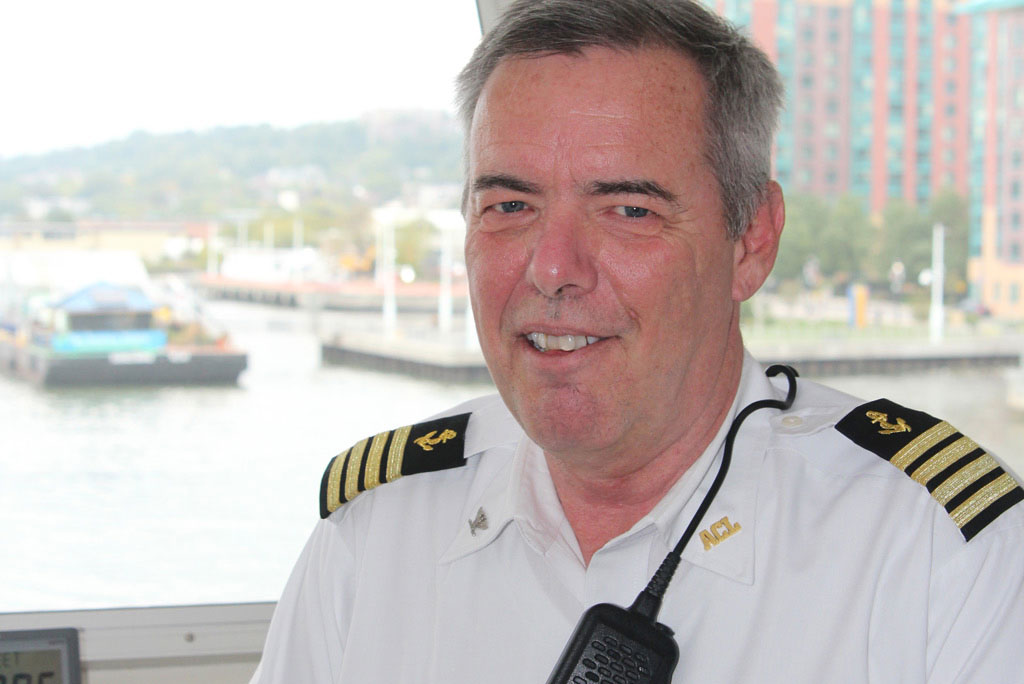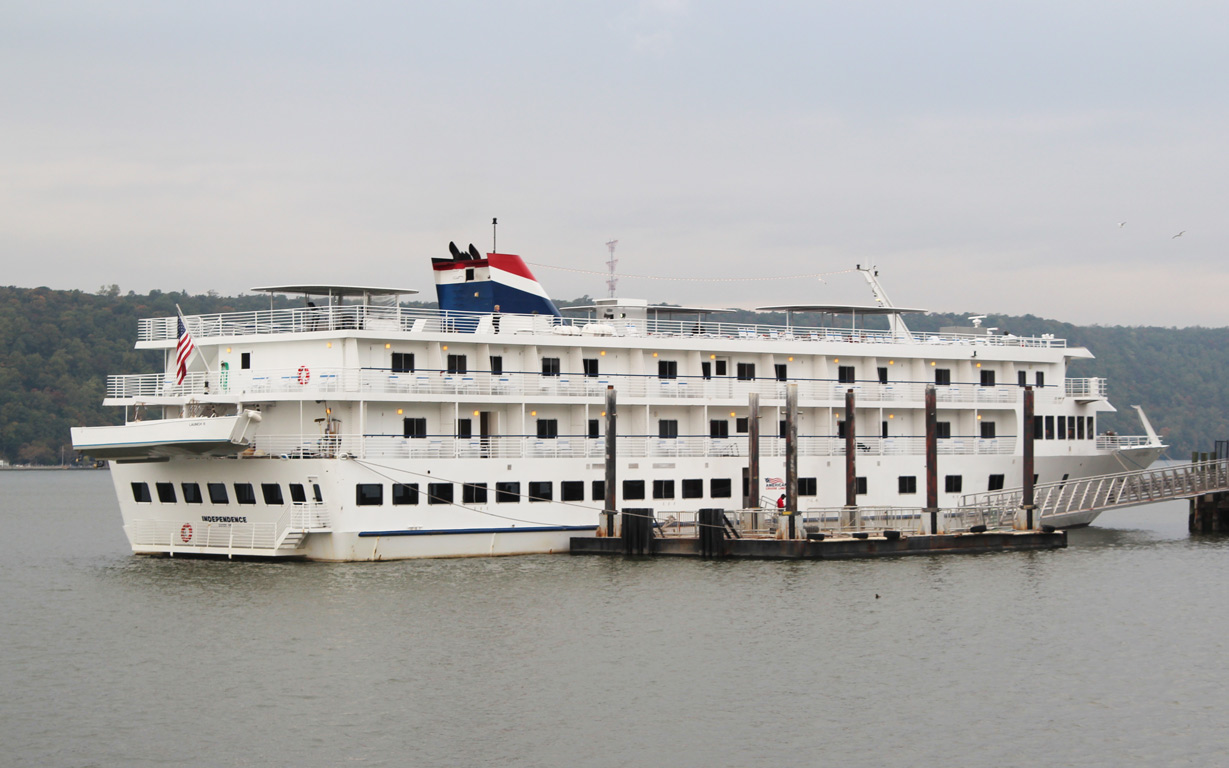 On the 100-passenger American Independence, which offers itineraries on domestic waterways, Captain Gregg Scheiferstein said a small maneuverable boat (American Cruise Lines calls their vessels boats) like the Independence can navigate into places the big ships can’t get near.
On the 100-passenger American Independence, which offers itineraries on domestic waterways, Captain Gregg Scheiferstein said a small maneuverable boat (American Cruise Lines calls their vessels boats) like the Independence can navigate into places the big ships can’t get near.
“It has a lot of strong points; it can do coastal journeys very comfortably,” he told Cruise Industry News. “It’s fully stabilized, so it’s very good in the small amounts of open water we sail in. At the same time, it’s a very shallow-draft vessel so it’s able to do some intimate areas on the East Coast and go places larger ships can’t. The boat is very maneuverable and is able to take us into small harbors, and that is the strongest thing it can do for the passengers.”
Navigation
Regarding river navigation, Scheiferstein called the iconic Hudson River an easier route. “It’s a deep-water route that’s fairly easy to navigate,” he said.
“There are areas we do, like the Intracoastal Waterway, that are extremely narrow and shallow. They take a different type of skill set most mariners don’t have to drive a ship this size through it.”
“There are areas we do, like the Intracoastal Waterway, that are extremely narrow and shallow. They take a different type of skill set most mariners don’t have to drive a ship this size through it.”
Scheiferstein said domestic routes and small harbors mean a lot of time spent maneuvering the vessel.
“It’s a much more hands-on maneuvering situation than other ships,” he noted. In addition, the bridge team serves as its own pilots.
“We’re in navigation waters all the time,” Scheiferstein continued. “We’re continually next to the scenery, close to the shore and close to tight navigation areas. We’re in piloting waters almost continuously.”
Therefore, if the ship is moving, Scheiferstein is on the bridge with a small team.
“If it’s a situation with heavy traffic or weather, we bring in another set of eyes,” he explained. “In general, in most navigation situations it’s myself and a helmsman.”

On the bridge, the captain pointed to the Rose Point Navigation system, essentially a specialized ECDIS for river use.
Scheiferstein said he never pushes a schedule. It is safety first.
“We’ve done these routes for 15 years now and know what we are capable of doing. We will alter things if we have to,” he said. “A lot of it is experience.”
The vessel’s schedule is adjusted around passenger comfort, slowing the ship down at dinner and making sure departure and arrival times featuring thruster use are avoided during scheduled dining times.
“Fuel consumption wise, it’s not a huge part of our consideration. We’ll burn the fuel we need to, and give the passengers the best possible experience and be in port when we need to be in port. We will save fuel when we can’t, there are times when we will single-engine operate the boat when it is safe to do so.”
Marine Background
Scheiferstein grew up in what he described as a little fishing village in Ohio on Lake Erie.
“People find it odd,” he said. “The house I lived in had a dock behind it. I had a dingy before a bicycle. I was always in boats as a kid and went straight into the Coast Guard out of high school.”
With the Coast Guard, he spent time working aboard ice breakers and buoy tenders.
“I had a great captain who allowed us to maneuver the ship at a young age, and I got used to boats this size,” he recalled.
From the Coast Guard, he went to the Great Lakes Maritime Academy and worked in the yacht sector, close to home, while his children were small.
As the kids grew up, he went back to sea, working for a marine spill response outfit and then joining American Cruise Lines.
“You add the passenger dimension, it changes the lifestyle,” Scheiferstein said. “As far as the job goes and what I do up here, it’s very similar. The passenger interaction is a huge part of what we do. It’s a lifestyle choice.”
With a high repeat rate, the company’s passengers are well-traveled and highly educated individuals, paying a premium on trips with the company, which has U.S.-flagged ships. Scheiferstein gives bridge tours, joins passengers in the lounge and often eats with guests as his schedule allows, also making a habit to meet them at the gangway after port days.
“Our passengers tend to have successful careers, and are extremely diverse,” he said. “It’s a fascinating group of people.”
Intracoastal
Having sailed seven seasons with the company, Scheiferstein said he has sailed on just about all the line’s ships, including the Mississippi paddle wheelers.
“The Mississippi River is considerably different from operating on the East Coast. Of all the things I’ve done in the marine world that is the most different.”
Out of the company’s portfolio, Scheiferstein said his affection was the Intracoastal Waterway.
“It’s my forte. I enjoy operating in very shallow and narrow, tight areas. I’ve done it long enough so I am comfortable in it.
“My overall responsibility is the safety of passengers and crew. I have a very skilled hotel manager who has a world of experience managing a hotel which is what I have on the back of this boat. I typically stay out of hotel operations unless I can be of use to them. That being said, I’m very involved in managing the deck side and the safety side.”
After a long career in the marine world, the focus of the captain remains the same.
“It’s a similar job to what it has always been with the exception of what you use to get the job done. What you’re trying to do is get the boat safely from A to B, which is what it’s always been.”
A good captain must remain focused on the task at hand, Scheiferstein advised.
“It’s about focusing on the right things and not getting distracted by trivialities,” he said.
For those looking to navigate smaller vessels, he called the American Cruise Lines’ ships unusual.
“Some people are good in very quick situations, where we get into small and narrow areas that take nonstop concentration, and they have the ability not to get ruffled by things,” Scheiferstein said. Most captains with the company have Coast Guard backgrounds and have spent a lot of time sailing in similar areas.
For young people going to sea today, he recommended going to a maritime academy first.
“You can still work your way up, but if I was just starting out I would look seriously at going to a maritime academy right out of the box,” Scheiferstein continued. “The strongest piece of advice I have is you have to love the profession.”
When not aboard, he returns home to Cleveland, generally in the winter, spending time going to sports games and as an anonymous guest on other cruise ships. Of two sons, Scheiferstein said his youngest was studying sound engineering, while his oldest son is looking to go to a maritime academy after a summer spent working onboard.
Excerpt from Cruise Industry News Quarterly Magazine: Winter 2016/2017




